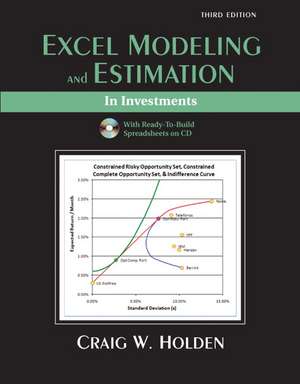Excel Modeling and Estimation in Investments
Autor Craig W. Holdenen Limba Engleză Mixed media product – 3 mar 2008
This book focuses on active learning by teaching students how to build and estimate financial models using Excel so they understand the steps involved, rather than being handed completed spreadsheets.
Preț: 300.98 lei
Nou
Puncte Express: 451
Preț estimativ în valută:
57.59€ • 61.59$ • 48.02£
57.59€ • 61.59$ • 48.02£
Cartea nu se mai tipărește
Doresc să fiu notificat când acest titlu va fi disponibil:
Se trimite...
Preluare comenzi: 021 569.72.76
Specificații
ISBN-13: 9780132079907
ISBN-10: 0132079909
Pagini: 256
Dimensiuni: 216 x 279 mm
Greutate: 0.62 kg
Ediția:3Nouă
Editura: Pearson Education
Colecția Prentice Hall
Locul publicării:Upper Saddle River, United States
ISBN-10: 0132079909
Pagini: 256
Dimensiuni: 216 x 279 mm
Greutate: 0.62 kg
Ediția:3Nouă
Editura: Pearson Education
Colecția Prentice Hall
Locul publicării:Upper Saddle River, United States
Cuprins
Contents
Chapter 1 — Bond Pricing
Chapter 2 — Bond Duration
Chapter 3 — Bond Convexity
Chapter 4 — The Yield Curve
Chapter 5 — US Yield Curve Dynamics
Chapter 6 — Affine Yield Curve Models
Chapter 7 — Portfolio Optimization
Chapter 8 — Constrained Portfolio Optimization
Chapter 9 — Asset Pricing
Chapter 10 — Trading Simulations using @RISK
Chapter 11 — Portfolio Diversification Lowers Risk
Chapter 12 — Life-Cycle Financial Planning
Chapter 13 — Dividend Discount Models
Chapter 14 — Du Pont System of Ratio Analysis
Chapter 15 — Option Payoffs and Profits
Chapter 16 — Option Trading Strategies
Chapter 17 — Put-Call Parity
Chapter 18 — Binomial Option Pricing
Chapter 19 — Black Scholes Option Pricing
Chapter 20 — Merton Corporate Bond Model
Chapter 21 — Spot-Futures Parity (Cost of Carry)
Chapter 22 — International Parity
Chapter 23 — Useful Excel Tricks
Chapter 1 — Bond Pricing
Chapter 2 — Bond Duration
Chapter 3 — Bond Convexity
Chapter 4 — The Yield Curve
Chapter 5 — US Yield Curve Dynamics
Chapter 6 — Affine Yield Curve Models
Chapter 7 — Portfolio Optimization
Chapter 8 — Constrained Portfolio Optimization
Chapter 9 — Asset Pricing
Chapter 10 — Trading Simulations using @RISK
Chapter 11 — Portfolio Diversification Lowers Risk
Chapter 12 — Life-Cycle Financial Planning
Chapter 13 — Dividend Discount Models
Chapter 14 — Du Pont System of Ratio Analysis
Chapter 15 — Option Payoffs and Profits
Chapter 16 — Option Trading Strategies
Chapter 17 — Put-Call Parity
Chapter 18 — Binomial Option Pricing
Chapter 19 — Black Scholes Option Pricing
Chapter 20 — Merton Corporate Bond Model
Chapter 21 — Spot-Futures Parity (Cost of Carry)
Chapter 22 — International Parity
Chapter 23 — Useful Excel Tricks
Caracteristici
For undergraduate and graduate courses in corporate finance or financial management.
This book focuses on active learning by teaching students how to build and estimate financial models using Excel so they understand the steps involved, rather than being handed completed spreadsheets.
Ready-To-Build Spreadsheets
The accompanying CD provides ready-to-build spreadsheets for every chapter that dictates step-by-step instructions to the student. Since the CD provides instructions within each spreadsheet, so students do not have to refer back to the book for each step. This approach allows students to concentration on implementing financial formulas and estimation.
Excel Modeling and Estimation — The New Content
Several significant updates have been made to this edition, including:
This book focuses on active learning by teaching students how to build and estimate financial models using Excel so they understand the steps involved, rather than being handed completed spreadsheets.
Ready-To-Build Spreadsheets
The accompanying CD provides ready-to-build spreadsheets for every chapter that dictates step-by-step instructions to the student. Since the CD provides instructions within each spreadsheet, so students do not have to refer back to the book for each step. This approach allows students to concentration on implementing financial formulas and estimation.
Excel Modeling and Estimation — The New Content
Several significant updates have been made to this edition, including:
- Estimating firm valuation in a two-stage framework
- Estimating the cost of capital using the static CAPM based on the Fama-MacBeth method
- Estimating the cost of capital using the APT or Intertemporal CAPM based on the Fama-French three factor model
- Four international parity conditions
- A new chapter on Excel tricks
- Flexible content to use as a supplement with any textbook for a corporate finance course
- Opportunities to build from simple Excel examples to practical, real-world applications using Excel.
